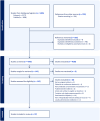Dynamic distribution of systemically administered antibiotics in orthopeadically relevant target tissues and settings
- PMID: 39530161
- PMCID: PMC11582342
- DOI: 10.1111/apm.13490
Dynamic distribution of systemically administered antibiotics in orthopeadically relevant target tissues and settings
Abstract
This review aimed to summarize the current literature on antibiotic distribution in orthopedically relevant tissues and settings where dynamic sampling methods have been used. PubMed and Embase databases were systematically searched. English-published studies between 2004 and 2024 involving systemic antibiotic administration in orthopedically relevant tissues and settings based on dynamic measurements were included. In total, 5385 titles were identified. After title and abstract screening, 97 eligible studies (43 different antibiotic drugs) were included. The studies covered both preclinical (42%) and clinical studies including healthy and infected tissues (21%) and prophylactic and steady-state situations (35%). Microdialysis emerged as the predominant sampling method in 98% of the studies. Most of the presented antibiotics (80%) were only assessed once or twice. Among the most extensively studied antibiotics were cefuroxime (18 studies), linezolid (9 studies) and vancomycin (9 studies). This review presents valuable insights into the microenvironmental distribution of antibiotics in orthopedically relevant target tissues and settings and seeks to provide a basis for improving dosing recommendations and treatment outcomes. However, it is important to acknowledge that our findings are limited to the specific drug, dosing regimens, administration method and target tissue, and are crucially linked to the selected PK/PD target.
Keywords: Antibiotics; bone; orthopaedic; penetration; pharmacokinetics.
© 2024 The Author(s). APMIS published by John Wiley & Sons Ltd on behalf of Scandinavian Societies for Pathology, Medical Microbiology and Immunology.
Figures



References
-
- Hackett DJ, Rothenberg AC, Chen AF, Gutowski C, Jaekel D, Tomek IM, et al. The economic significance of orthopaedic infections. J Am Acad Orthop Surg. 2015;23 Suppl:S1–S7. - PubMed
-
- Malizos KN. Global forum: the burden of bone and joint infections: a growing demand for more resources. J Bone Joint Surg Am. 2017;99(5):e20. - PubMed
-
- Metsemakers WJ, Smeets B, Nijs S, Hoekstra H. Infection after fracture fixation of the tibia: analysis of healthcare utilization and related costs. Injury. 2017;48(6):1204–1210. - PubMed
-
- Orfanos AV, Michael RJ, Keeney BJ, Moschetti WE. Patient‐reported outcomes after above‐knee amputation for prosthetic joint infection. Knee. 2020;27(3):1101–1105. - PubMed
Publication types
MeSH terms
Substances
LinkOut - more resources
Full Text Sources
Medical

